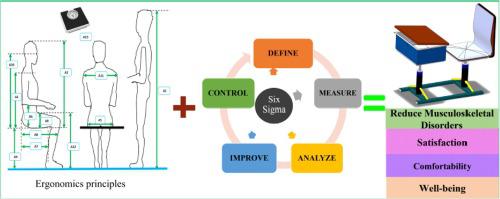Safety Science ( IF 6.1 ) Pub Date : 2021-11-22 , DOI: 10.1016/j.ssci.2021.105579 Ismail W.R. Taifa 1

|
Classroom-related musculoskeletal disorders (CMSDs) rates in low- and middle-income countries (LMICs) are increasing despite the ever-collective interest in occupational health and safety (OHS) and succeeding developments over time. To explore the problem (i.e., OHS) with its proposed solutions, this study integrated the Six Sigma methodology with ergonomics principles to eliminate the CMSDs. Participants were 478 students from India as a country amongst the LMICs. The age range, mean, and standard deviation were 17–37, 20.28, and 2.348 for male students and 17–26, 19.57, and 2.163 for female students, respectively (units in years). The study found that students are prone to high risks of getting CMSDs due to prolonged usage of poorly designed furniture. The CMSDs results are as follows: fatigue joint and muscle pain (71%), shoulder and neck tension (70%), headache (63%), neck pain (53%), back pain (51%), legs’ joints pain (46%), shoulders and muscles pain (42%), elbow pain (42%), sleeplessness (insomnia) (40%) and hand pain (39%). The proposed solutions include the two ergonomically designed students’ desks; students’ requirements and anthropometric measurements consideration; occupational health and safety workshops and/or seminars preparation; administration interventions; behavioural (personal) interventions, and other engineering interventions.
中文翻译:

一种以学生为中心的设计方法,通过六西格码方法与人体工程学串联减少印度的肌肉骨骼疾病
尽管人们对职业健康与安全 (OHS) 的兴趣日益浓厚,而且随着时间的推移取得了成功,但低收入和中等收入国家 (LMIC) 的课堂相关肌肉骨骼疾病 (CMSD) 发病率仍在上升。为探索该问题(即 OHS)及其提议的解决方案,本研究将六西格码方法与人体工程学原理相结合,以消除 CMSD。参与者是来自印度这个中低收入国家的 478 名学生。男学生的年龄范围、平均值和标准差分别为 17-37、20.28 和 2.348,女学生分别为 17-26、19.57 和 2.163(以年为单位)。研究发现,由于长时间使用设计不佳的家具,学生很容易患上 CMSD。CMSDs 结果如下:疲劳关节和肌肉疼痛 (71%),肩颈紧张 (70%)、头痛 (63%)、颈痛 (53%)、背痛 (51%)、腿关节痛 (46%)、肩部肌肉痛 (42%)、肘痛 ( 42%)、失眠(失眠)(40%)和手痛(39%)。提议的解决方案包括两个符合人体工程学设计的学生课桌;学生的要求和人体测量的考虑;职业健康与安全讲习班和/或研讨会的准备工作;行政干预;行为(个人)干预和其他工程干预。学生的要求和人体测量的考虑;职业健康和安全讲习班和/或研讨会的准备工作;行政干预;行为(个人)干预和其他工程干预。学生的要求和人体测量的考虑;职业健康和安全讲习班和/或研讨会的准备工作;行政干预;行为(个人)干预和其他工程干预。


























 京公网安备 11010802027423号
京公网安备 11010802027423号